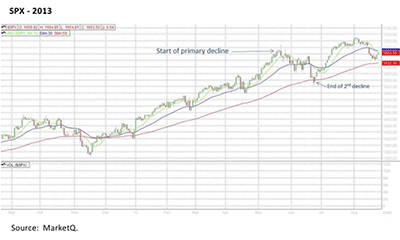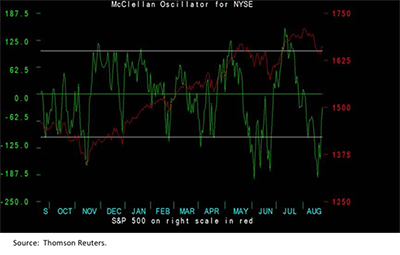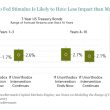Random Thoughts in the Summer Doldrums
by Jeffrey Saut, Chief Investment Strategist, Raymond James
August 26, 2013
On October 10, 2008, with the S&P 500 (SPX/1663.50) at 839.80, the bottoming process began when 92.6% of all stocks traded on the NYSE made new annual lows. That’s a six standard deviation event, which is supposed to occur only twice in a lifetime. At the time many investors were liquidating their portfolios because they did not heed Benjamin Graham’s advice in his epic book The Intelligent Investor, “The essence of investment management is the management of RISKS, not the management of RETURNS. Well-managed portfolios start with this precept.” Consequently, investors who failed to respect the Dow Theory “sell signal” of November 2007 ended up incurring substantial losses into the beginning of the October 2008 bottoming process. Moreover, they continued to liquidate their portfolios right into the S&P 500’s (SPX/1663.50) ultimate intraday bottom of 666.79 on Friday 3/6/09. Surprisingly, I was on Bloomberg TV that Monday (3/2/09) stating, “The bottoming process that began last October is complete this week and we are ‘all in’.” I have been pretty constructive on equities ever since.
I did, however, recommend raising cash in the spring of 2010, 2011, and 2012, on a tactical trading basis, with the strategy of putting that cash back to work during the summer months; and, that is all you had to get right in those years to produce decent equity returns. This year my mantra has been that “Sell in May and go away” is not going to work as I targeted the mid-July through mid-August timeframe as the first window for a meaningful decline to begin. To be precise, it was the timing/quantitative models (not me) that gave the exact date of 7/19/13 for the stock market’s internal energy to be totally exhausted. Yet, I have been the one taking the heat for that “call” because the SPX made a few marginal closing highs above the July 19th high of 1692. Nevertheless, the fact of the matter is that the stock market’s internal energy was indeed used-up in mid-July with the various averages virtually going sideways and then pulling back 4.1% over the past three weeks (intraday high to intraday low). Interestingly, this recent pullback is remarkably similar to the May 22nd to June 6th decline of this year (see chart on page 3). That initial decline was roughly 5% and left the NYSE McClellan Oscillator extremely oversold. The SPX subsequently rallied 3.5% into its June 18th peak before resuming the decline into its June 24th low. The entire pullback encompassed 7.5%. If that chart pattern repeats this time it suggests the rally attempt that began last Thursday should peak between 1684 and 1696. Personally, I don’t think the SPX has the energy to make it back through my 1684 “pivot point.” On the downside, I still think the SPX has an appointment into the 1530 (April low) to 1560 (June low) zone.
Of course, I continue to think such pullbacks are within the context of a bull market since my confidence remains high that we are in a new secular bull market. Last week I carried that message to Nashville where I spoke with institutional accounts and presented at events for our financial advisors and their clients. Regrettably, most of them think you need a “feel good” environment for a bull market to exist. But, when you get that “feel good” environment it tends to be late in the game. Ladies and gentlemen, the equity markets do not care about the absolutes of good and bad, they only care about if things are getting better or worse. And, things are definitely getting better! To emphasize that point, in my presentations I always discussed the American Industrial Renaissance (onshoring) whereby manufacturing jobs are coming back to America. To wit, chemical companies are expanding into the U.S. because of our low natural gas prices. Airbus just broke ground for a massive new plant in Mobile, Alabama, VW is expanding its facility in Tennessee, Samsung is spending $4 billion in Austin, Texas, Michelin is investing $750 million in South Carolina, Denso is spending $750 million in five different states, and the list goes on.
Next is the energy independence theme, with the U.S. becoming the largest natural gas producer in the world in 2015 and likely going to be energy independent in the 2020 – 2025 timeframe. Yet most importantly, I think the 2010 mid-term election marked a turning point in the political arena whereby over the next five years we are going to elect smarter policymakers and therefore get smarter policies. Unsurprisingly, for that view I have been termed naive. In my presentations, I talk about numerous reasons for that belief. Unfortunately, there is not enough space in this missive to go into much detail on this theme. I will, however, offer some quips from last Thursday’s Wall Street Journal (WSJ) article titled “A New Law to Liberate American Business” by Thomas G. Stemberg, founder of Staples Inc., as an example of “smarter policies.” The author begins by noting:
“There are so many government impediments to business today that the next Staples—and its 50,000 jobs—might never get off the ground. Chief among those roadblocks: the blizzard of bureaucratic red tape that buries businesses and stifles job creation. These include the additional 16 million hours that vending-machine and chain-restaurant business owners must spend complying with new food regulations each year. But there is also the license that magicians require to do a rabbit disappearing act, which mandates an annual fee, surprise inspections and a rabbit disaster plan. All told, American business faces 46,758 pages of rules to live by in the Federal Register. ... [Job] creators know that regulatory relief can't come soon enough. In 2010, the Small Business Administration pegged the annual cost of complying with regulations at $1.75 trillion. The SBA report covered 2008 and the burden has certainly grown since. A May 2013 report by the Heritage Foundation, "Red Tape Rising," found that new regulatory costs added in 2012 totaled $23.5 billion.”
Wow, no wonder job creation has been slow to recover. But, help may be on the way because of Senators Angus King and Roy Blunt. Their bill, “The Regulator Improvement Act of 2010,” would create a bipartisan Regulatory Improvement Commission whose purpose is to recommend cuts in the regulatory regime. Those recommended cuts would require a mandatory up-or-down, nonamendable, vote by Congress. The King-Blunt concept has already worked as seen with “The Defense Base Realignment and Closure Commission” (BRAC), which has been responsible for the closure of 121 major military bases since 1988. As the WSJ article states:
“In short, the BRAC Commission gave politicians what they crave most: cover. Nobody back home could blame them for losing a military base. The King-Blunt proposal will give representatives the same cover with regulations. The bipartisan Regulatory Improvement Commission – with members appointed by the president and congressional leaders – would tackle one area of regulation at a time. Its members would be charged with finding regulations that are duplicative, like the 642 million hours employees will spend complying with redundant regulations this year, according to the American Action network. The panel also will try to identify obsolete regulations, maybe resembling the arcane rules the Federal Communications Commission leverages to achieve whatever regulatory aims the commissioners desire.”
I happen to believe all of this is pretty bullish over the longer-term. But, in the near-term, I remain cautious for all of the stated reasons.
The call for this week: The initial leg down from the May 22nd peak ended on June 6th, which left the McClellan Oscillator very oversold (see chart on page 3), and was followed by an ensuing 3.5% rally into the July 2nd top of 709.67. Subsequently, the secondary decline began on June 16th and ended on June 24th, taking another 94 points off of the SPX. The current chart pattern looks very similar to that of the May 22nd to June 6th drop, and if that pattern repeats, it suggests the current rally attempt should peter out in the 1684 to 1696 zone, followed by a secondary decline that carries the SPX into the prescribed 1530 – 1560 zone where a trading bottom should be anticipated. As a sidebar, I am hosting a conference call (call 1-877-601-1467 and ask for the Lord Abbett conference) this Thursday at 4:15 p.m. with one of the best stock pickers I know. He is Tom O’Halloran, the portfolio manager of the Lord Abbett Growth Leaders Fund (LGLAX/$19.83). He will be talking about the “six rivers of growth” in a slow growth economy, those being: the ongoing digitization of society; the dynamics of mass consumerism; the growth of emerging nations; the innovation of modern medicine; the American manufacturing renaissance; and the North American energy revival. Tom will also talk about individual stock ideas. I suggest you listen to this important call.
















